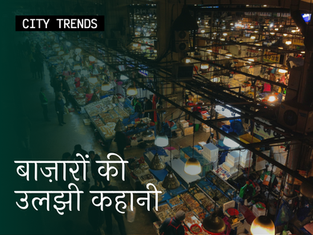top of page


Disparities From Source To Structure
As summer intensifies, India’s smaller cities face an escalating water crisis, where turning on a tap often means uncertainty. Despite national initiatives like AMRUT 2.0 promising improved access, local challenges—aging infrastructure, stalled projects, and uneven supply—persist. While some cities innovate with smart meters, others remain stuck in outdated systems. Can these ambitious plans truly bridge the gap between infrastructure and water justice?
May 114 min read


पानी की असमानता: स्रोत से सप्लाई तक
गर्मियाँ बढ़ने के साथ, भारत के छोटे शहरों में पानी की किल्लत और बढ़ रही है, जहाँ नल खोलना अक्सर अनिश्चितता लेकर आता है की पानी आया की नहीं । AMRUT 2.0 जैसे राष्ट्रीय कार्यक्रम बेहतर पानी पहुँचाने का वादा करते हैं, लेकिन यहाँ की पुरानी पाइपलाइन, अधूरे प्रोजेक्ट और अनियमित सप्लाई जैसी समस्याएँ बनी हुई हैं। कुछ शहर स्मार्ट मीटर से नवाचार कर रहे हैं, तो कई पुराने सिस्टम में फंसे हैं। क्या ये बड़े प्लान सच में बुनियादी ढांचे और पानी की न्याय के बीच की दूरी पाट पाएंगे?
May 119 min read


The Urban Bazaar Conundrum
Across India, weekly haats have long been more than just markets; they are vital spaces of culture, trade, and community. From Kalimpong’s Bihibare Haat to Guwahati’s Beltola Bazaar, haats continue to evolve in urban settings, even as civic challenges arise. As cities rush to build curated versions like Dilli Haat, are there ways to preserve the organic spirit of traditional haats while adapting to urban realities?
Jun 28, 20245 min read


बाज़ारों की उलझी कहानी
भारत के कोने-कोने में लगने वाले साप्ताहिक हाट सिर्फ़ बाज़ार नहीं हैं — ये व्यापार, संस्कृति और समुदाय का हिस्सा हैं। कालिम्पोंग का बिहीबारे हाट हो या गुवाहाटी का बेलतला बाज़ार, ये हाट आज भी शहरों में बदलती ज़रूरतों के साथ चलते जा रहे हैं। लेकिन जैसे-जैसे शहरों में दिल्ली हाट जैसे 'क्यूरेटेड' बाज़ार बनते हैं, सवाल उठता है कि क्या शहरी बदलावों के बीच हम इन पारंपरिक हाटों की असली रौनक और अपनापन बनाए रख पाएंगे?
Jun 20, 20245 min read
bottom of page